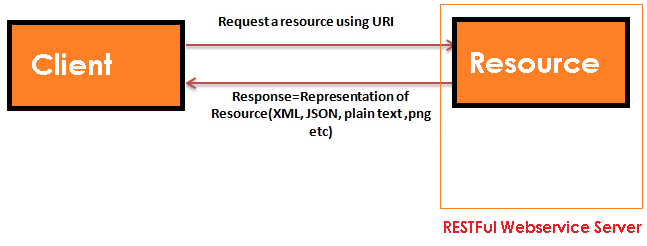REST -Representation State Transfer
REpresentational State Transfer (REST) is a stateless client-server architecture in which the web services are viewed as resources and can be identified by their URIs. Web service clients that want to use these resources access via globally defined set of remote methods that describe the action to be performed on the resource.
It consists of two components
-
REST server: which provides access to the resources
-
REST client : which accesses and modify the REST resources.
In the REST architecture style, clients and servers exchange result representations of resources by using a standardized interface and protocol. REST isn’t protocol specific, but when people talk about REST they usually mean REST over HTTP.
The response from server is considered as the result representation of the resources. This result representation can be generated from one resource or more number of resources. REST allows that resources have different result representations, e.g.xml, json etc. The rest client can ask for specific result representation via the HTTP protocol

HTTP methods:
RESTful web services use HTTP protocol methods for the operations they perform.
Methods are:
-
GET: It defines a reading access of the resource without side-effects. This operation is idempotent i.e. they can be applied multiple times without changing the result
-
PUT: It is generally used for updating resouce. It must also be idempotent.
-
DELETE: It removes the resources. The operations are idempotent i.e. they can get repeated without leading to different results.
-
POST: It is used for creating a new resource. It is not idempotent.
Idempotent
Idempotent means result of multiple successful request will not change state of resource, after initial application
For example:
GET is idempotent. If Delete() is idempotent method because when you first time use delete, it will delete the resource (initial application) but after that, all other request will have no result(same result) because resource is already deleted.
Post is not idempotent method because when you use post to create resource, it will keep creating resource for each new request, so result of multiple successful request will not be same.
Some important features of Restful web services are:
1.Resource identification through URI:Resources are identified by their URIs (typically links on internet). So, a client can directly access a RESTful Web Services using the URIs of the resources (same as you put a website address in the browser s address bar and get some representation as response).
2.Uniform interface: Resources are manipulated using a fixed set of four create, read, update, delete operations: PUT, GET, POST, and DELETE.
3.Client-Server: A clear separation concerns is the reason behind this constraint. Separating concerns between the Client and Server helps improve portability in the Client and Scalability of the server components.
4.Stateless: each request from client to server must contain all the information necessary to understand the request, and cannot take advantage of any stored context on the server.
5.Cache: to improve network efficiency responses must be capable of being labeled as cacheable or non-cacheable.
6.Named resources - the system is comprised of resources which are named using a URL.
7.Interconnected resource representations - the representations of the resources are interconnected using URLs, thereby enabling a client to progress from one state to another.
8.Layered components - intermediaries, such as proxy servers, cache servers, gateways, etc, can be inserted between clients and resources to support performance, security, etc.
9.Self-descriptive messages: Resources are decoupled from their representation so that their content can be accessed in a variety of formats, such as HTML, XML, plain text, PDF, JPEG, JSON, and others.